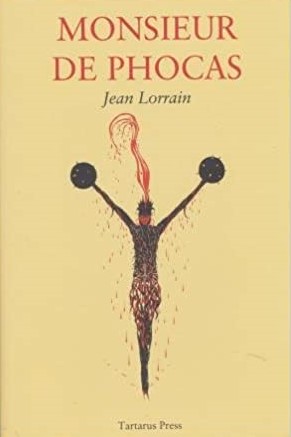 By JEAN LORRAIN (Tartarus Press; 1901/1994/2015)
By JEAN LORRAIN (Tartarus Press; 1901/1994/2015)
A key text of the Decadent Movement of the late 19th Century, which began (in part) with Joris-Karl Huysmans’s 1884 À REBORNS/AGAINST NATURE. The mention of the Huysmans novel is appropriate, as MONSEIUR DE PHOCAS is in many respects a distorted mirror image of that classic, and even, as the nonfiction introduction states, something of a bookend to what À REBORNS helped commence.
A reading of that introduction is essential to a full understanding of MONSIEUR DE PHOCAS. The introduction and afterword, both of them highly learned, were written by the book’s translator “Francis Amery” (actually Brian Stableford), who uncovers a number of similarities between the life of Jean Lorrain (1855-1906), a prolific author and lover of fin de siècle Paris, and that of the eponymous Monsieur de Phocas.
The novel begins with one Duc de Fréneuse, a notorious libertine, turning up at the Paris home of the book’s unidentified narrator (presumably Jean Lorrain). There Fréneuse announces that he’ll be exiling himself from France and changing his name (for some reason) to Monsieur de Phocas. He also entrusts the narrator with a manuscript, the bulk of which forms the remainder of the novel.
Fréneuse/Phocas’s writings initially seem a more-or-less disjointed series of observations about his obsessions (paintings in particular, descriptions of which take up a great deal of the text), his relationships and his surroundings. This guy is a bundle of contradictions, constantly raging against the decadence and depravity of the people with whom he comes into contact, yet also harboring an overpowering fascination for all things grotesque. This leads to a lot of overt self-loathing, a minutely described opium trip and nostalgic memories of his childhood, spent (like Jean Lorrain’s) in the Normandy based seaside town of Fécamp—apparently a blissful contrast to Paris, where “I grow ulcers; Paris has made me cowardly, libertine and cruel.”
An especially important component of Phocas’s existence is a character named Claudius Ethal. An English painter who’s left his native land to settle in Paris, Ethal (who’s believed to have been patterned on Oscar Wilde) exerts a disturbing hold over Phocas, being primarily responsible, Phocas claims, for his gradual drift into depravity. Whether Ethal is truly “real” is a question raised in the afterword by Amery/Stableford, and one that is never concretely answered by Phocas’s increasingly disordered, hallucination-plagued writings.
As a Descent-Into-Madness account this novel, episodic though it might seem, is quite potent. It also contains a great deal of ahead-of-its-time grotesquerie (a hallucinatory passage involving a severed head in particular) and a wonderfully poetic depiction of late 1900s Paris that’s well captured by Stableford’s highly erudite translation.
A word about the publication: it’s a hardcover from Tartarus Press, with contents identical to those of Dedalus’s 1994 trade paperback publication of MONSIEUR DE PHOCAS (albeit with updated typography and photographic illustrations). It’s well worth acquiring for those wanting a sturdy and attractively designed edition of this book, although Dedalus deserves credit for getting to it first.
